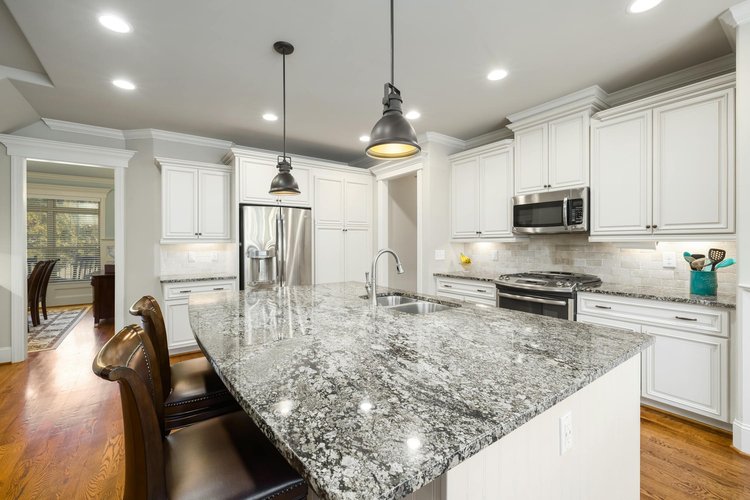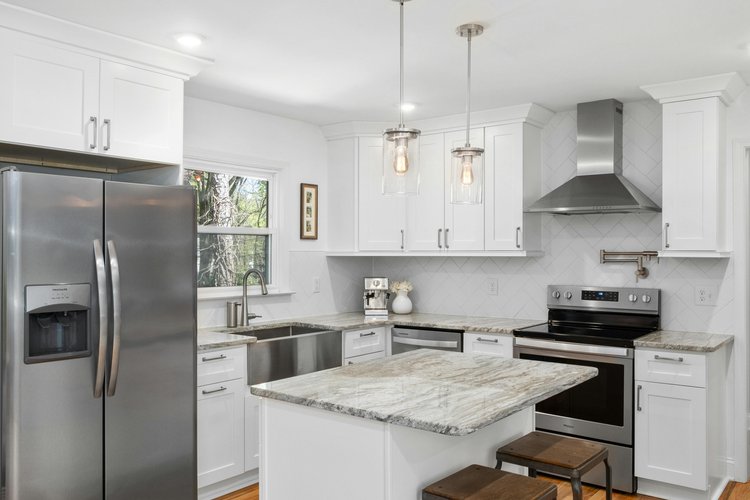What is the best kitchen countertop?
Choosing the right countertop can make or break your kitchen design. It's a huge investment, so you want something that looks great and stands up to daily use. As you choose a countertop, you'll want to consider your style and how you actually use your kitchen. Do you want a countertop that's really tough and easy to clean? Or are you more partial to adding an accent piece to impress friends and family?
Whether you lean towards the timeless appeal of granite or marble, the durability of quartz, or the rustic charm of butcher block, each option has its unique benefits. To make your choice easier, let's look at a few countertops that might work in your kitchen.
Granite

Granite begins as molten magma that crystallizes slowly beneath the Earth's surface, forming natural stone. Composed of minerals like quartz, feldspar, and mica, each piece of granite has its own story. The result is a variety of patterns and colors, including red, pink, gray, or white.
While granite may not be as stain-resistant or available in as many colors as quartz, it's still relatively durable. Granite countertops can resist moisture and heat, but thinner slabs may be prone to cracking or chipping if they're subjected to heavy impacts. As a natural stone, granite is porous and can absorb liquids, which could mean potential staining. In particular, you'll want to be mindful of things like raspberries, wine, coffee, and mustard. While there are many types of protective finishes for countertops, we recommend an oil-based sealant. These deeply penetrate the stone to protect against moisture and stains while enhancing the granite's natural color and veining. Keep in mind that oil sealers wear down over time, so you'll need to reseal your countertops every six to twelve months.Marble

Marble is formed when limestone is subjected to intense heat and pressure deep within the Earth, transforming it into a dense, crystalline rock.
Known for its polished sheen, marble features patterns that range from delicate swirls to bold, flowing lines. These distinct veins take shape as minerals like clay, silt, and iron oxides become trapped in the stone, creating contrasting colors and patterns that appear as streaks. Marble, like granite, is naturally porous and can soak up liquids, leading to stains. You can use an oil-based sealer to prevent stains and bring out the stone's natural beauty. As mentioned before, you'll likely need to reapply every six to twelve months as the finish wears down over time.While marble may not be as durable as granite or quartz, many people prefer it because, as a natural material it adds timeless quality and classic elegance for any home.
Quartz

Quartz countertops were invented in the 1960s and have become just as popular as granite and marble. However, quartz differs from marble and granite because it is a mineral rather than a rock.
To create quartz countertops, manufacturers grind quartz into a fine powder and mix it with resin, a type of plastic that acts as a binding agent to hold the quartz particles together. In addition to resin, quartz countertops can contain crushed glass, marble dust, and bits of granite. The mixture is then poured into molds, compressed, cured, and polished to form durable, nonporous slabs.
Various pigments can give quartz countertops different colors, resulting in a wide range of hues, from vibrant blues and greens to warm reds and rich browns. Beyond just adding color, pigments can also mimic the veining of natural stone.
Unlike granite or marble, quartz surfaces do not absorb liquids because they're made primarily from resin, making them completely nonporous. As such, quartz countertops don't need to be sealed. In fact, attempting to seal quartz can actually create problems as the sealant may leave a visible film on the surface that requires removal, leading to a messy and tedious cleanup.
Overall, quartz is a great option, offering durability that matches or exceeds that of granite and marble. Its resistance to scratches, stains, and heavy impact makes it a practical choice for high-traffic areas while providing long-term value to your home.
Butcher Block

Butcher block countertops are created by gluing multiple pieces of wood together to create a visually striking surface. These countertops can be made from numerous types of wood, but hardwoods like maple, walnut, and oak are especially valued for their strength. For a splash of color, cherry and red oak offer warm reds and browns, while birch and beech add cozy tones to the room.
The price of butcher block depends on the quality of the wood used and how thick the slab is, but generally, butcher block countertops are far less expensive than stone or quartz.
To maintain butcher block, you can apply an oil-based or polyurethane finish, depending on your preference.
An oil-based finish gives a soft, natural look but requires frequent reapplication. This is because oil-based sealants should be frequently refinished as they penetrate the wood and wear down with use. Over time, the oil can evaporate and become less effective at protecting the surface from moisture and stains.
On the other hand, a polyurethane finish provides a hard, durable coating with a glossy or semi-gloss appearance that requires less frequent reapplication. However, while it offers excellent protection against moisture and stains, polyurethane can be prone to visible scratches and cutting marks if used for food preparation. To protect your butcher block, use cutting boards and avoid placing sharp objects directly on it.
Overall, two of the best things about butcher block are its price tag and the fact that it can be easily refinished.
When picking a countertop, it's worth thinking about both your style and how you use your kitchen. Natural stone, engineered materials, or wood all have their perks. Talking to professionals can help you make the best choice and keep your kitchen looking great for years to come.
